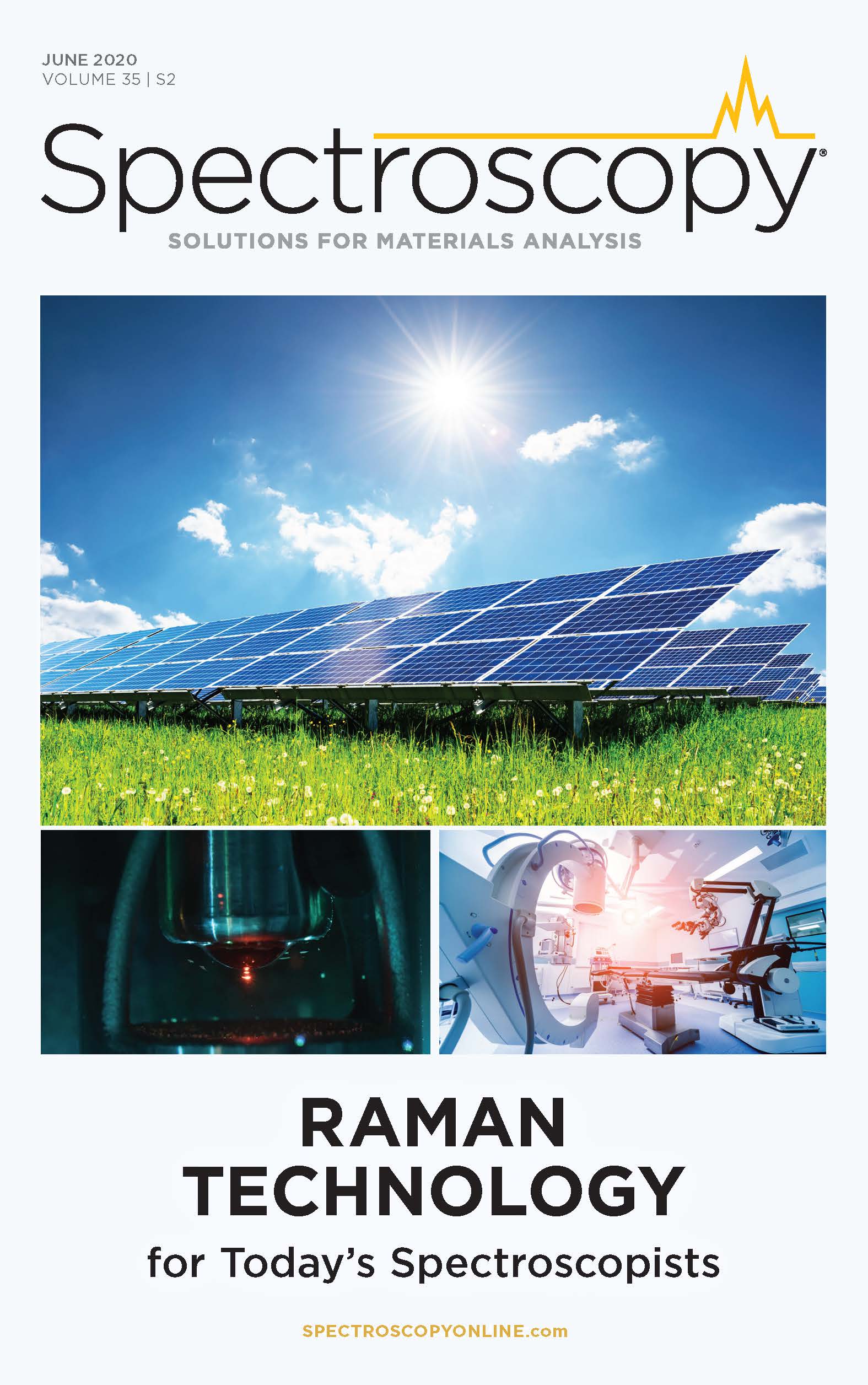Applications of Confocal Raman Spectroscopy and Imaging in the Medical Device Industry
Special Issues
Raman spectroscopy and imaging techniques are well suited for the characterization of surfaces, interfaces, and coatings to support research, development, and manufacturing of medical devices. Here, we describe applications in surface modifications and coatings, differentiation of drug polymorphs, degradation of biomaterials, and forensic identification of unknown materials.
Manufacturing of medical devices requires the highest level of quality to ensure optimal device performance and patient safety. Raman spectroscopy and imaging techniques are well suited for the characterization of surfaces, interfaces, and coatings to support research, development, and manufacturing of medical devices. Their strengths include chemical information (molecular fingerprint), imaging sub-micrometer chemical features, depth profiling of chemistry nondestructively, identification of drug polymorphs, and the ability to image in various environments. All of these are important for understanding material properties as they are received, processed, and after exposure to different environmental conditions. Raman spectroscopy and imaging can also be used for identifying unknown or foreign materials. This article highlights several real-world applications, including characterization of medical device surface modifications and coatings, differentiation of drug polymorphs, degradation of biomaterials, and forensic identification of unknown materials.
Medical devices are designed to target specific disease states and to treat trauma injuries, ultimately improving the quality of life for patients by restoring bodily function, mobility, and longevity. The field is very diverse, with several large markets, including cardiovascular (stents, grafts), cardiac rhythm devices (implantable pacemakers and cardioverter-defibrillators, atrial fibrillation ablation catheters), perfusion devices (blood pumps, oxygenators), neuromodulation (implantable drug pumps, spinal cord stimulation), diabetes management (glucose sensors, drug delivery), and surgical tools and consumables (staples, sutures). Common analytical challenges in medical device manufacturing include analysis of organic and inorganic species, coatings and thin films (such as diamond-like carbon and Parylene), identification of drug polymorphs (such as paclitaxel or rapamycin), degradation of polymers and biomaterials under different environmental conditions (such as biological fluids and sterilization), and unknown material identification (such as fibers and particles). Raman spectroscopy is well suited to the characterization of medical device materials and interfaces to gain insight into surface cleanliness, contamination, adhesion, lubricity, and intentional surface modifications.
Raman spectroscopy measures the intensity of inelastically scattered light (monochromatic light) by a sample as a function of wavelength (1). An incident laser causes chemical bonds in the sample to gain or lose characteristic amounts of energy corresponding to different vibrational modes. Because Raman activity results from a change of polarizability, the resulting spectra are dominated by peaks that correspond to symmetric stretching and bending modes. In contrast, Fourier transform-infrared (FT-IR) spectroscopy activity results from a change in dipole moment by absorption of IR light, and IR spectra are dominated by peaks that correspond to asymmetric stretching and bending modes (1). Therefore, Raman spectroscopy is a complementary technique to FT-IR spectroscopy, and a great addition to a material testing laboratory. A comparison of the two techniques is highlighted in Table I. One strength of the Raman technique is that measurements can be performed through glass, in fluids, and in tissue. Furthermore, the confocal Raman microscope allows non-destructive chemical depth profiling with lateral and depth resolution of ~350 nm and ~500 nm, respectively (2). This is important for analyzing buried interfaces through transparent and semi-transparent materials.
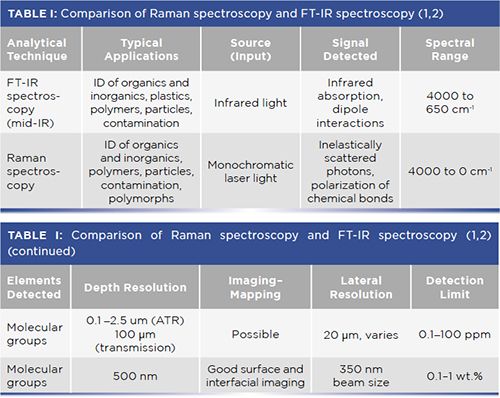
Good sample handling and preparation techniques are necessary for the analysis of medical devices, because often they are large, non-flat, and have been handled or been in contact with other materials (3). For example, fingerprints, disposable laboratory gloves, and polyethylene bags can easily deposit residues (such as fatty acids, siloxanes, and slip agents) onto the material surface of interest that will easily be detectable by Raman (4,5). It is also advised to capture optical images of the samples of interest prior to conducing any analytical testing. For the analysis of material interfaces, it is recommended that the material or device component of interest be embedded in epoxy and mechanically cross-sectioned, polished, or microtomed, to preserve the integrity of the interfaces. If these techniques are not available, then the use of a clean uncoated razor blade is another efficient way to cross-section a material to gain access to bulk or interfacial regions. The examples provided below highlight the use of confocal Raman for the characterization of medical devices.
Methods
The Confocal Raman instrument used for the applications described here consisted of a WITec alpha300 R (Suite 5.1 software) with a 532 nm laser. The Scope A1 was outfitted with two objectives: Zeiss EC EPIPLAN 20x/0.4 and Nikon Plan 100x/0.9 NCG, WD 0.26. A Zygo NewView 6300 White Light Interferometer was used to measure the drug eluting stent (DES) coating thickness. A Bruker Tensor 27 System with a Hyperion 2000 microscope and 20x attenuated total reflection (ATR) objective was used for the PVC particle example. A Leica UC7 Ultramicrotome was used to prepare the cross-section of polyurethane tubing.
Results and Discussion
Example 1: Drug Polymorph Identification
Identification of drug polymorphism is an important criterion when designing and manufacturing drug-containing medical devices. Polymorph structure during the crystallization process is influenced primarily by solvent effects, impurities, and temperature. The crystalline form will control activity and solubility of the drug. In addition, understanding the use condition of the device therapy and desired drug release kinetics is very important during the design stage. Raman spectroscopy is a good technique to determine drug crystallinity, since it is relatively quick, nondestructive, and only a small amount of sample is required in comparison to X-ray diffraction (XRD) and differential scanning calorimetry (DSC) (6,7).
Paclitaxel, a cytotoxic chemotherapy drug, is commonly used on medical devices for its anti-proliferative properties to treat restenosis (narrowing of arteries) in cardiovascular disease patients. Two products on the market include drug-coated balloons (DCB) and drug-eluting stents (DES) (8,9). Their use conditions differ in that DCB require a fast bolus release within several minutes, whereas DES require a slower release over several months from the substrate to the tissue. The most stable polymorphic states of paclitaxel are dihydrate, anhydrous, and amorphous, and their solubility in water ranges quite dramatically: dihydrate (0.7 µg/mL), anhydrous (6 µg/mL), amorphous (30 µg/mL) (6). A thorough understanding of the polymorph composition is important for designing, manufacturing, and registering drug combination products containing paclitaxel.
For this example, Raman spectroscopy was used to discriminate between different paclitaxel polymorphs. Figure 1 shows representative Raman spectra of anhydrous, dihydrate, and amorphous paclitaxel. Spectral differences are clearly notable among the three spectra, specifically in the carbonyl stretching region (C=O) between 1680 and 1780 cm-1. The dihydrate form shows three peaks centered at ~1700, ~1713, and ~1738 cm-1. The anhydrous form shows two peaks centered at ~1705 and ~1713 cm-1. The amorphous paclitaxel shows only one broad peak centered at ~1722 cm-1. These results demonstrate that Raman spectroscopy can differentiate between the three common polymorphs. In addition, confocal Raman imaging can also be used to evaluate the composition of paclitaxel coatings on DES and DCB.
Figure 1: Raman spectral comparison of three paclitaxel polymorphs (dihydrate, anhydrous, and amorphous) commonly present on drug-coated medical devices (closeup shown as
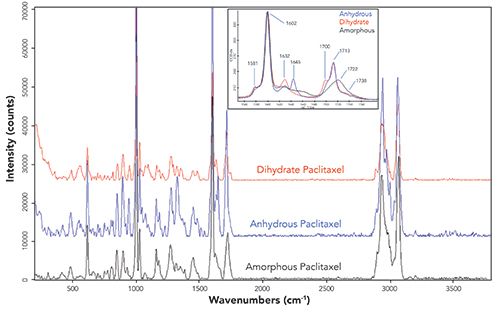
insert subfigure). Spectral differences are clearly notable in the carbonyl and amide stretching region from 1760 to 1500 cm-1 and can be used to distinguish between the three different polymorphs.
Example 2: Non-Destructive Analysis of a Drug-Eluting Stent Coating
Drug-eluting coronary stents are designed to slowly elute an anti-proliferative drug (for example, rapamycin or paclitaxel) into surrounding tissue over an extended period after the initial implantation of the device to reopen arteries (9). The release of drug from the device is controlled by the degradation of a biodegradable polymer matrix into which the drug is formulated. Also, it should be noted that a thin Parylene barrier layer is commonly applied to the base metal substrate (stainless steel, CoCr) to increase coating adhesion (10,11). The thickness, uniformity, and surface texture of drug-eluting stent coatings are important parameters to understand, control, and measure during device manufacturing.
For this example, the thickness and uniformity of a rapamycin/polylactic acid (PLA) coating applied to a Parylene-primed metal stent were characterized by confocal Raman imaging and white light interferometry. Representative optical images of the DES sample are shown in Figure 2a to highlight the analysis area of interest. The confocal nature of the technique allowed spectra to be acquired near the surface of the coating (red spectrum) and approximately 20 µm beneath the top surface (blue spectrum) as show on Figure 2b. The red spectrum showed bands consistent with rapamycin and PLA, whereas the blue spectrum showed bands consistent with Parylene.
Figure 2: (a) Representative optical images of drug eluting stent (DES) with a rapamycin/ PLA coating. Red box shows area of analysis. b) Spectral comparison of the top (red) and sub-surface layer (blue). Peaks labeled with (P) correspond to Parylene C and peaks labeled with (D) correspond to drug. (c) Confocal Raman depth profile of drug coating on metal stent using peaks characteristic of drug (1632 cm
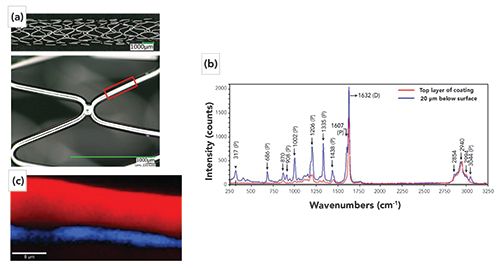
-1, red) and Parylene C (1607 cm-1, blue).
The spatial composition and thickness of the stent coatings (rapamycin + PLA + Parylene) were analyzed by acquiring an x-z cross section image parallel to the major axis of the stent. Raman spectra were obtained confocally from the top layer of the rapamycin/PLA coating down to approximately 20-µm sub-surface in increments of 0.5 µm. The 1632 cm-1 band was selected to represent the distribution of drug and the band at 1607 cm-1 was selected to represent the distribution of Parylene. The confocal Raman band map is shown in Figure 2c. The intensity of the band consistent with Parylene was strongest just above the metal surface, whereas the intensity of the band consistent with rapamycin was strongest above the Parylene layer up to the top of the coating.
The average coating thickness was measured by white light interferometry. The refractive index of the coating is an important parameter required to accurately determine the coating thickness. Here the refractive index of PLA (~1.4) was used to correct the coating thickness, because the refractive index of the coating (ratio of drug/ polymer 1:1) and drug is not known (12). The average coating thickness was measured to be 25.9 ±3.5 μm (n = 4).
Example 3: Degradation of Biomaterials
Understanding the failure mechanism of materials can aid in the design of new and better materials to slow the degradation of current materials. Polyurethane has long been used in medical devices due to its chemical stability in the body over time. Explanted leads made of polyurethane often exhibit a cloudy or cracked appearance on the surface of the lead in portions with mechanical fatigue, where superficial oxidative degradation causes cracking of the surface and as a result appears white or opaque (13,14). In other areas, the surface is unchanged, according to the naked eye. The cracking and cloudiness are thought to be due to degradation of the urethane. By evaluating the extent of chemical changes at the surface, it is hoped to gain better insight into the mechanism of degradation.
Raman spectra taken at various points along the cloudy surface of an explanted lead show chemical differences from the pristine or clear polyurethane. Figure 3a shows the cloudy regions of polyurethane exhibit a shift in the carbonyl peak from 1620 cm-1 to 1600 cm-1 that is likely related to the hard segment chain scission and an increase in hydrogen bonding (15). Additionally, there is a new peak that is observed at 1156 cm-1, which could be attributed to the C-C crosslinking of the soft segment that is formed during the degradation process.
Figure 3: (a) Spectral comparison of pristine polyurethane 80A (blue) and oxidized polyurethane (green). The spectra show a shift of the carbonyl peak from 1614 cm-1 to 1600 cm-1, as well as a slight broadening of the peak as the polyurethane oxidizes. A new peak is also formed at 1152 cm-1. (b) Optical and Raman spectral images of a cross-sectioned 20-year explanted polyurethane lead. The Raman image shows a thin 1–2-μm oxidized layer of polyurethane on the surface of the pristine polyurethane material.
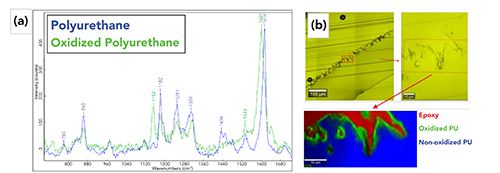
Using confocal Raman to map these chemical changes in a cross-sectioned lead sample provides a visual distribution of where the oxidized and non-oxidized polyurethane are located. The Raman images in Figure 3b show a thin 1–2 μm oxidized layer of polyurethane at the surface of the lead tubing, and down into the cracked regions of the tubing. However, past this oxidized layer the polyurethane does not show further degradation.
This analysis confirms that the chemical degradation mechanism of the polyurethane is a surface degradation as opposed to a bulk material type of degradation such as a hydrolysis (13,14). Understanding the method of degradation can then allow further engineering of lead materials to either eliminate or minimize the surface degradation. Modification of polyurethane leads could include surface treatments such as barrier coatings, or additives that would help scavenge the oxygen and prevent surface degradation.
Example 4: Forensic Analysis of Unknown Material
Confocal Raman spectroscopy is well suited for the analysis of unknown materials that can originate from numerous sources during device manufacturing and packaging (15,16). The technique has excellent spatial resolution (~350 nm) for probing suspect regions of interest on the surface, subsurface, or bulk. In addition, the technique provides information below 650 cm-1 for inorganic species and provides complementary information to infrared spectroscopy (1).
For this example, an unknown green particle (approximately 0.7 cm diameter) was detected in the packaging of a medical device product. The particle was isolated onto the surface of a KBr pellet, and analyzed by vibrational spectroscopy to determine the identity of the material so its origin could be investigated. Raman and ATR-IR spectra were acquired from the particle. The spectra obtained for the green particle are shown in Figure 4. The ATR-IR spectrum (top) yielded signals for methyl and methylene (3000–2800 cm-1), carbonyl (1735 cm-1, probably due to a conjugated ester or ketone), ester (1285 cm-1), and aromatic groups (3071, 3034, 1603, and 1577 cm-1). The signals at 1125 and 1073 cm-1 could be due to ester groups; however, fingerprint bands can also appear in that range. The Raman spectrum (bottom) yielded signals for aromatic (3069, 1596, and 1574 cm1), methyl and methylene (3000–2800, 1440, and 1384 cm-1), and carbonyl (1719 cm-1) groups. Signals at 684 and 645 cm-1 are consistent with C-Cl bands; however, C-Cl bands typically appear over a very broad range (600–800 cm-1), and their identification can be challenging (1).
Figure 4: (top) ATR-IR and (bottom) Raman spectra of the green particle found in packaging. The green particle is composed of plasticized (phthalate) polyvinyl chloride (PVC).
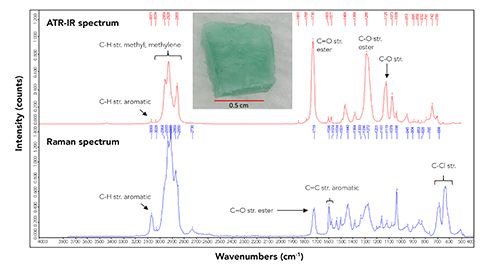
A library search was conducted of the ATR-IR spectrum, and several phthalate species were identified as possible matches. Phthalates are compounds having the general structure of an ortho-substituted aromatic ring with ester side chains. Phthalates are commonly used to plasticize polyvinylchloride (PVC). As signals that are consistent with C-Cl groups were observed in the Raman spectrum, it is likely that the green particle is composed of PVC heavily plasticized with a phthalate compound. This is consistent with the pliable nature of the particle.
Example 5: Non-Destructive Analysis of Parylene Barrier Coatings
Barrier coatings are commonly used to prevent interaction between a material and the environment in which it will be used. In the medical device field, there are a small subset of patients who are sensitive to titanium, which is a tissue contacting material found in existing, market released devices (17). A barrier coating, such as Parylene, can prevent further complications for a patient after having a device implanted.
Being able to characterize coatings in a non-destructive manner is very useful for in-line inspections, and quality control testing where the cost of the product is too great to sacrifice devices on a regular basis. Confocal Raman is well suited for non-destructive analysis due to its limited interaction volume and the capability to image through transparent layers and films.
For this example, the thickness and uniformity of Parylene barrier layers covering silicone and polyurethane substrates were characterized non-destructively by generating spectral images in the x-z dimensions. A spectrum is collected at each pixel in the image, and then a partial least square fitting routine is performed to generate the component distribution images. The Raman images in Figure 5 show the Parylene coatings measure approximately 5 μm thick, and show no gaps or uncoated regions along the substrate materials.
Figure 5: (blue) Raman reference spectra for Parylene , (green) silicone, (red) polyurethane, and Raman images showing the conformal Parylene barrier coatings on various substrate materials.
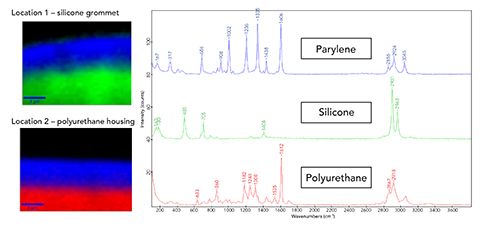
Conclusion
In summary, the examples provided here demonstrate that confocal Raman spectroscopy and imaging are well suited for the characterization of medical devices. This technique provided chemical identification of drug polymorphs, characterization of drug and polymer coatings, and identification of unknown materials, all in a non-destructive manner. The confocal nature of the technique provides high spatially resolved chemical information, both laterally and with depth, to further understand the composition and integrity of coatings and material interfaces in both transparent and semi-transparent samples. Confocal Raman spectroscopy is a great technique to compliment other analytical tools in a material testing laboratory.
References
- N.B. Colthup, L.H. Daly, and S.E. Wiberley, Introduction to Infrared and Raman Spectroscopy (Academic Press, Cambridge, Massachusetts, 3rd Ed., 1990).
- S. Breuninger, M. Henrich, and T. Dieing, Spectroscopy16(4), 8–9 (2017).
- ASTM E334-01, Standard Practice for General Techniques of Infrared Microanalysis (2013).
- B.R. Strohmeier, J.D. Piasecki, and A. Plasencia, Spectroscopy27(7), 36–47 (2012).
- M. Nouman, et. al., Polym. Degrad. Stab. 13, 293–252 (2017).
- R.T. Liggins, W.L. Hunter, and H.M. Burt, J. Pharma. 86(12), 1458–1463 (1997).
- J.H. Lee, et. al., Bull. Korean Chem. Soc.22(8), 925–928 (2001).
- B. Scheller, Herz 36, 232 (2011).
- T. Htay and M.W. Liu, Vasc. Health Risk Manag. 1(4), 263–276 (2005).
- Specialty Coating Systems, www.scscoatings.com
- M. CieÅlik, et al., Materials Science and Engineering: C32(1), 31–35 (2012).
- G. Wypych, Handbook of Polymers (ChemTech Publishing, Toronto, Ontario, Canada, 2nd Ed., 2016).
- M. Ebert, et al., J. Biomed. Mater. Res A 75(1), 175–184 (2005).
- S.J. McCarthy, et al., Biomaterials 18, 1387–1409 (1997).
- S.R. Skorich and M.E. Benz, Polym. Mater. Sci. Eng. 79, 506–507 (1998).
- M. deVeij, et al., J. Raman Spectrosc.40, 297–307 (2009).
- M. Goutam, et al., Indian J. Dermatol. 59(6), 630 (2014).
William Theilacker is a Principal Scientist of Microscopy and Surface Analysis at Medtronic, in Minneapolis, Minnesota. Tony Anderson is a Senior Scientist of Microscopy and Surface Analysis at Medtronic, in Minneapolis, Minnesota. Direct correspondence to: bill.theilacker@medtronic.com
AI-Powered SERS Spectroscopy Breakthrough Boosts Safety of Medicinal Food Products
April 16th 2025A new deep learning-enhanced spectroscopic platform—SERSome—developed by researchers in China and Finland, identifies medicinal and edible homologs (MEHs) with 98% accuracy. This innovation could revolutionize safety and quality control in the growing MEH market.
New Raman Spectroscopy Method Enhances Real-Time Monitoring Across Fermentation Processes
April 15th 2025Researchers at Delft University of Technology have developed a novel method using single compound spectra to enhance the transferability and accuracy of Raman spectroscopy models for real-time fermentation monitoring.
Nanometer-Scale Studies Using Tip Enhanced Raman Spectroscopy
February 8th 2013Volker Deckert, the winner of the 2013 Charles Mann Award, is advancing the use of tip enhanced Raman spectroscopy (TERS) to push the lateral resolution of vibrational spectroscopy well below the Abbe limit, to achieve single-molecule sensitivity. Because the tip can be moved with sub-nanometer precision, structural information with unmatched spatial resolution can be achieved without the need of specific labels.
